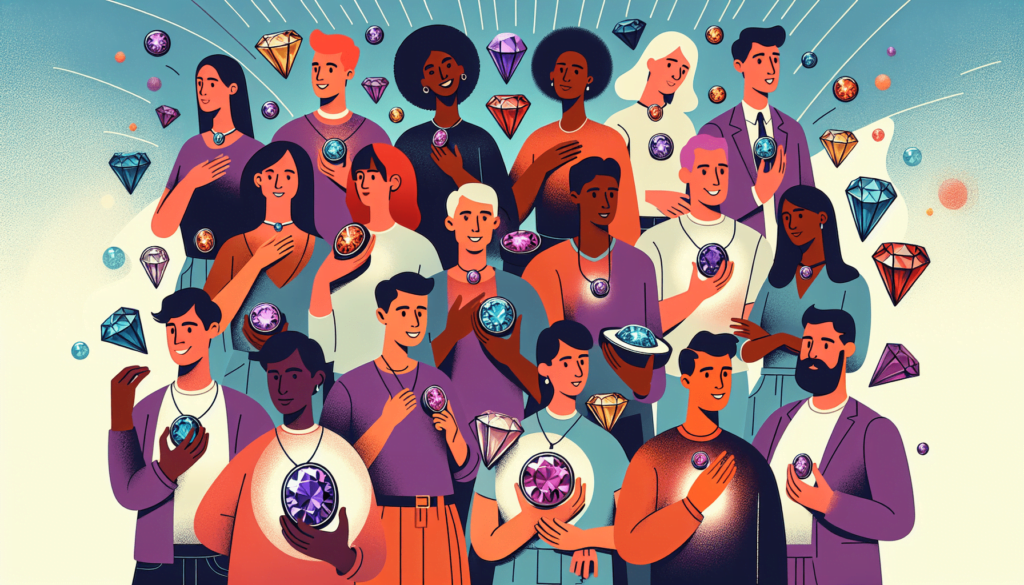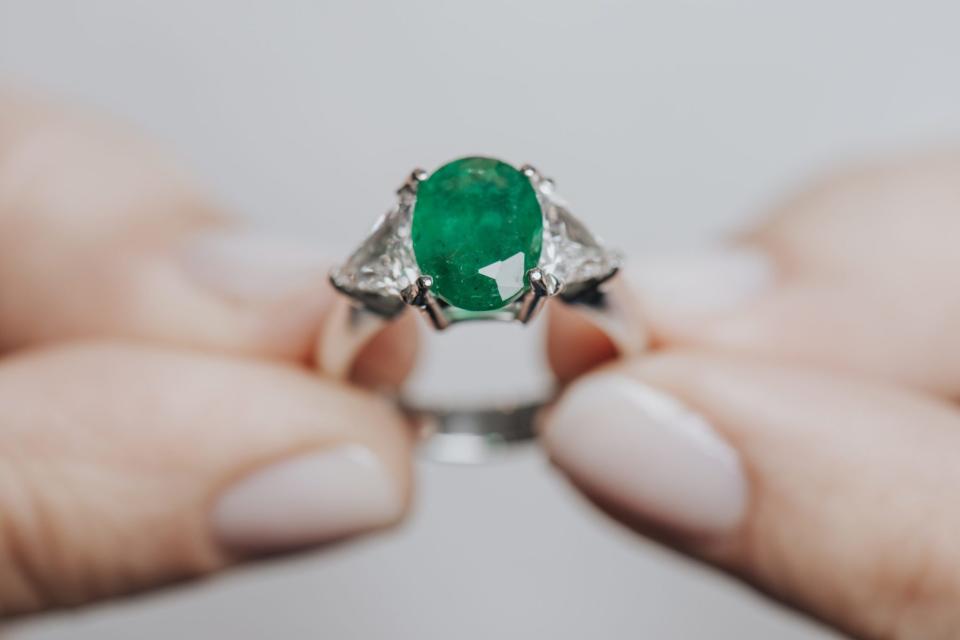In today’s ever-evolving world, there has been a noticeable shift in the preferences of Gen Z and millennials when it comes to precious stones. Increasingly, these age groups are favoring gemstones over diamonds, with lab-grown options gaining popularity. This shift in preference can be attributed to their ethical and sustainable concerns surrounding traditional diamond mining practices. Gemstones provide a wider array of colors and options, making them a more appealing choice for the younger generation. As the rising popularity of gemstones continues to make waves, it’s clear that a new era in jewelry preferences is upon us.
Emerging Preference for Gemstones over Diamonds
The Shifting Favor of Gemstones
In recent years, there has been a noticeable shift in preference among younger generations, specifically Gen Z and millennials, who are increasingly favoring gemstones over diamonds. The allure of gemstones, with their unique colors and styles, has captured the attention and imagination of these age groups. The traditional dominance of diamonds as the go-to gemstone for special occasions and luxury jewelry is being challenged by the growing popularity of gemstones.
Comparison between Gemstones and Diamond Preferences
When comparing the preferences for gemstones and diamonds, it becomes clear that gemstones offer a wider variety of colors and options. Diamonds, while prized for their brilliance and clarity, are limited in their color range, with the majority falling within the white or near-colorless category. Gemstones, on the other hand, come in a multitude of vibrant and mesmerizing hues, allowing individuals to express their personal style and individuality through their choice of gemstone.
Generational Trends and Patterns in Gemstone Preference
Analyzing the patterns of gemstone preference among different generations reveals interesting insights. Gen Z and millennials, known for their emphasis on self-expression and unique identification, gravitate towards gemstones that enable them to make a statement with their jewelry choices. This preference aligns with their desire to create a distinct and personalized look, setting them apart from previous generations who leaned more towards the classic elegance of diamonds.
Rise of Lab-Grown Gemstones
Growing Popularity of Lab-Grown Gemstones
One significant factor contributing to the shift towards gemstones is the increasing popularity of lab-grown gemstones. These man-made gemstones offer an alternative to natural gemstones, providing consumers with a more affordable option without compromising on quality or beauty. The accessibility of lab-grown gemstones makes them an attractive choice for those who are looking to make a fashion statement or invest in jewelry without breaking the bank.
Methods in Creating Lab-Grown Gemstones
Lab-grown gemstones are created using advanced technological processes that simulate the natural conditions under which gemstones are formed. By recreating the necessary heat and pressure, scientists are able to grow gemstones that possess the same physical and chemical properties as their natural counterparts. This innovative method allows for a more controlled and sustainable production of gemstones, reducing the environmental impact associated with traditional mining practices.
Comparative Quality of Lab-Grown Gemstones to Natural Ones
One of the key concerns when it comes to lab-grown gemstones is their quality in comparison to natural ones. However, advancements in technology have made it possible to produce lab-grown gemstones that are virtually identical to natural gemstones in terms of their physical and chemical properties. From the naked eye, it is nearly impossible to distinguish between a lab-grown gemstone and a natural one. This assurance of quality has contributed to the increasing acceptance and adoption of lab-grown gemstones by consumers.
Ethical Concerns Driving the Shift: Rising Popularity of Gemstones
Ethical Issues Prevalent in Traditional Diamond Mining
One of the driving factors behind the shift towards gemstones is the ethical concerns surrounding traditional diamond mining. Diamonds have long been associated with controversy, particularly regarding human rights abuses and environmental damage associated with mining operations. The prevalence of blood diamonds, also known as conflict diamonds, has fueled consumer skepticism and a desire for more ethical alternatives.
Consumer Awareness on Ethical Concerns
With increased access to information and the rise of social media, consumers today are more aware and conscious of the ethical concerns associated with the products they purchase. The younger generations, in particular, are known for their social activism and commitment to making a positive impact on the world. As a result, they are actively seeking out ethical alternatives to traditional diamond jewelry, driving the demand for gemstones that are sourced and produced in an ethically responsible manner.
Influence of Ethical Concerns on Purchasing Decisions
These ethical concerns are not simply fleeting interests but are increasingly becoming essential factors in purchasing decisions. Consumers are prioritizing transparency, traceability, and accountability when it comes to their jewelry choices. The desire to align their personal values with their consumption habits has led many individuals to choose gemstones, knowing that they are making a more ethical and responsible choice.
The Move Toward Sustainability
Sustainable Aspects of Gemstone Acquisition
In addition to the ethical considerations, the move towards gemstones can also be attributed to the growing consumer drive for sustainability in luxury goods. Gemstone acquisition, whether through mining or lab-grown methods, offers a more sustainable alternative to diamond mining. The environmental impact of gemstone mining is relatively lower compared to diamond mining, as it often involves smaller-scale operations and does not contribute to the destruction of ecosystems on the same scale.
Consumer Drive for Sustainability in Luxury Goods
Consumers, especially younger generations, are increasingly placing emphasis on sustainability when making purchasing decisions, including in the luxury goods sector. The desire to reduce their carbon footprint and support businesses that prioritize sustainability has led many individuals to opt for gemstones over diamonds. By choosing gemstones, consumers can enjoy the beauty and luxury of fine jewelry while also aligning with their commitment to protecting the environment.
Impact on the Gemstone Market due to Sustainability
The growing demand for sustainable luxury goods, including gemstone jewelry, has had a significant impact on the gemstone market. Jewelry brands and retailers are recognizing the importance of sustainability and are incorporating it into their business practices. From responsibly sourcing gemstones to using recycled metals, the industry is adapting to meet the changing preferences of consumers. This evolving market dynamic has further contributed to the rise in gemstone popularity.

Aesthetic Appeal of Gemstones
Variety of Colors and Styles Offered by Gemstones
One of the undeniable attractions of gemstones is the vast range of colors and styles they offer. From the deep blue of sapphires to the fiery red of rubies and the vivid green of emeralds, gemstones possess a captivating allure that is difficult to resist. This variety allows individuals to express their personality and style through their choice of gemstone, making each piece of jewelry unique and distinctive.
The Role of Uniqueness and Diversity in Gemstone Preference
In a world where personal expression and individuality are highly valued, the role of uniqueness and diversity cannot be overlooked. Gemstones provide an opportunity for individuals to showcase their individual style and stand out from the crowd. Unlike diamonds, which are often associated with traditional engagement rings, gemstones offer a fresh and modern approach to jewelry, allowing individuals to make a bold statement and reflect their personal taste.
Influence of Fashion Trends on Gemstone Popularity
Fashion trends play a significant role in shaping consumer preferences, and the popularity of gemstones is no exception. The fashion industry has embraced the allure of gemstones, featuring them prominently in clothing, accessories, and runway shows. This exposure has undoubtedly influenced consumer perceptions and contributed to the rising popularity of gemstones. By aligning with current fashion trends, gemstones have become a sought-after choice for those looking to stay on-trend and make a fashion statement.
Economic Considerations
Price Comparisons between Diamonds and Gemstones
Another factor contributing to the shift towards gemstones is the economic consideration. While diamonds have long been associated with high price tags, gemstones offer a more affordable option without compromising on beauty or quality. The abundance and variety of gemstones allow for a wide range of price points, making them accessible to a larger demographic. This affordability factor has made gemstones an attractive alternative for those who want to invest in fine jewelry without a substantial financial burden.
Potential Economic Benefits of Choosing Gemstones
In addition to their affordability, choosing gemstones can have potential economic benefits. As the demand for gemstones continues to rise, their value in the market is also increasing. Gemstones that were once overlooked or undervalued are now being recognized for their beauty and uniqueness, driving up their worth. For individuals who invest in gemstone jewelry, there is the potential for a return on investment in the future as the market continues to grow and evolve.
Market Responses to the Rise in Gemstone Popularity
The rise in gemstone popularity has not gone unnoticed by the market. Jewelry brands and retailers are capitalizing on this trend by expanding their offerings to include a wider range of gemstones. This diversification allows them to cater to the evolving preferences of consumers and capture a larger share of the market. Additionally, the rise of online shopping platforms has made gemstone jewelry more accessible than ever, further fueling the demand for gemstones.

Online Shopping and Gemstone Popularity
Influence of Online Shopping on Gemstone Sales
The rise of online shopping has had a significant impact on the popularity of gemstones. With just a few clicks, consumers can explore a vast selection of gemstone jewelry from the comfort of their own homes. Online platforms provide detailed product descriptions, images, and customer reviews, allowing individuals to make informed purchasing decisions. This convenience and accessibility have contributed to the growing interest and sales of gemstone jewelry.
The Trust Factor in Online Gemstone Purchases
One important element in the success of online gemstone sales is the trust factor. Consumers want to ensure that they are purchasing genuine gemstones of high quality. Online retailers have responded to this concern by providing certifications and detailed information about the origins and characteristics of their gemstones. This transparency and commitment to quality have built trust among consumers, giving them the confidence to make online gemstone purchases.
How Online Marketing is Driving the Popularity of Gemstones
Online marketing strategies have played a crucial role in driving the popularity of gemstones. Social media platforms, influencers, and online advertisements have all contributed to the increased visibility and desirability of gemstone jewelry. The use of captivating visuals, educational content, and personalized recommendations has allowed brands to engage with their target audience and create a desire for gemstone jewelry. The power of online marketing cannot be underestimated, as it has played a significant role in fueling the gemstone trend.
The Cultural Impact behind Gemstone Preference
Traditional Cultural Associations of Gemstones
Gemstones have long held cultural significance and associations in various societies around the world. For example, sapphires are often associated with wisdom and royalty, while emeralds are seen as symbols of rebirth and love. These traditional cultural associations add a layer of meaning and symbolism to gemstone jewelry, making them even more appealing to consumers who value heritage and tradition.
Impact of Contemporary Cultural Themes on Gemstone Choices
In addition to traditional cultural associations, contemporary cultural themes also influence gemstone choices. For instance, the rise of the wellness and self-care movement has led to an increased interest in gemstones believed to have healing properties. From amethysts for tranquility to citrine for abundance, individuals are drawn to gemstones that align with their personal well-being and spiritual beliefs. The fusion of traditional and contemporary cultural themes adds depth and relevance to gemstone preferences.
Emerging Cultural Trends in Gemstone Jewelry
As culture evolves and trends come and go, so do preferences in gemstone jewelry. New cultural movements, such as sustainability and gender inclusivity, are shaping the way gemstones are viewed and desired. These emerging trends have influenced the designs and choices of gemstone jewelry, highlighting the importance of continuously adapting to cultural shifts. By staying attuned to these emerging cultural trends, the gemstone industry can continue to thrive and remain relevant.

The Future of Gemstones
Potential Future Trends in the Gemstone Market
Looking ahead, the future of gemstones appears promising. As younger generations continue to drive the shift towards gemstones, the market is likely to expand further. The demand for sustainably sourced and ethically produced gemstones is expected to continue to grow, creating opportunities for innovation and advancement in the industry. Furthermore, the ability to customize and personalize gemstone jewelry through online platforms is likely to become even more prevalent, catering to the desire for unique and individualized pieces.
Innovation in the Gemstone Industry
To meet the evolving preferences and demands of consumers, the gemstone industry is embracing innovation. From the development of new cutting techniques to the discovery and use of rare and unusual gemstone varieties, there is a constant drive for innovation in the industry. This innovation not only offers consumers a wider range of choices but also enhances the overall appeal and desirability of gemstone jewelry.
The Longevity of the Gemstone Trend
While trends may come and go, the shift towards gemstones seems to have strong staying power. The various factors driving this trend, including the desire for ethical and sustainable alternatives, the aesthetic appeal of gemstones, and the cultural impact behind gemstone preferences, indicate that gemstones are here to stay. As long as consumers continue to value individuality, self-expression, and responsible consumption, the gemstone trend is likely to endure.
Impact on the Diamond Industry
How the Diamond Industry is Reacting to the Gemstone Trend
The rise in gemstone popularity has undoubtedly had an impact on the diamond industry. As consumer preferences shift towards gemstones, diamond companies are being forced to adapt their strategies and offerings. There has been an increasing emphasis on promoting the unique qualities of diamonds, such as their durability and timelessness, to differentiate them from gemstones. Additionally, some diamond companies have started incorporating gemstones into their collections in an attempt to capture a share of the growing market.
Potential Strategies for the Diamond Industry to Regain Market Share
To regain market share, the diamond industry may need to focus on addressing the ethical concerns surrounding traditional diamond mining. By implementing more transparent and responsible mining practices, companies can rebuild trust and attract consumers who value ethical sourcing. Furthermore, the diamond industry can explore collaborations with gemstone jewelry designers and brands to offer a wider range of options that cater to changing consumer preferences.
Long-Term Implications for the Diamond Industry
The long-term implications for the diamond industry are uncertain. While diamonds will likely remain a symbol of luxury and tradition, the growing preference for gemstones poses a challenge. The diamond industry will need to adapt and evolve to meet the changing demands of consumers and address the ethical and sustainability concerns that are driving the shift towards gemstones. By embracing innovation and incorporating responsible practices, the diamond industry can strive to maintain its relevance and appeal in the ever-evolving market.


